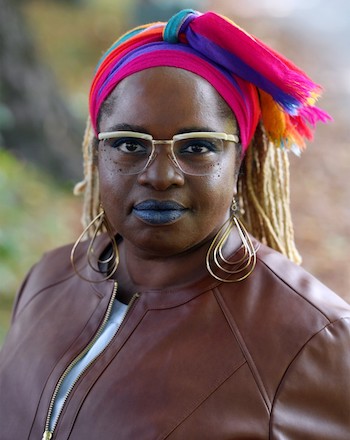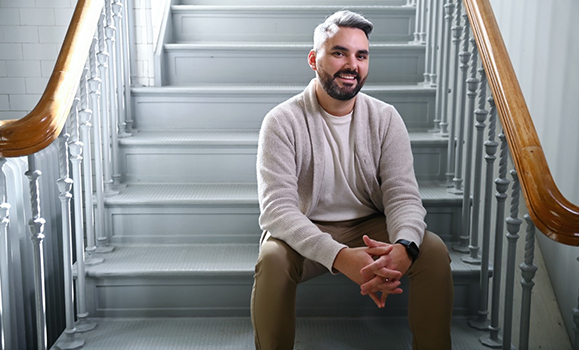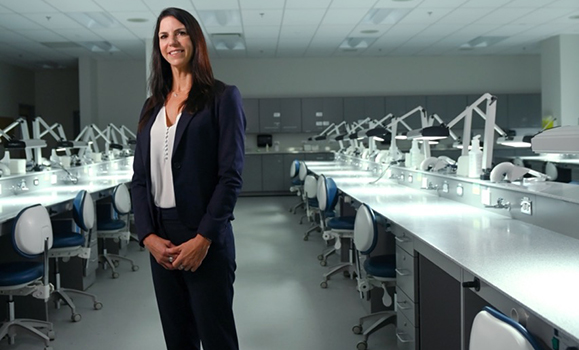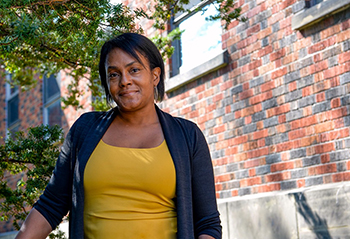“Only patients are permitted because of COVID-19.”
That was what she was told. Which may not have seemed unusual in pandemic times.
But Dr. Barb Hamilton-Hinch recalls staring in disbelief at two white men walking together in the direction of care, while she had just been informed she would not be permitted to accompany her mother, who was very ill at the time. Why then, was the man in front of her allowed to accompany his friend or family member? When Dr. Hamilton-Hinch asked if she was being treated differently because of the colour of her skin, she was immediately told she could join her mother.
Dr. Hamilton-Hinch is the assistant vice-provost of equity and inclusion at Dalhousie. She says it shouldn’t be the responsibility of the patient to continue to educate people on the needs of diverse populations.
“I shouldn’t have to use my doctor title to get ‘better’ care,” she says. “I think that speaks volumes about the change that needs to happen.”
Further reading: A conversation with Dalhousie’s new AVP equity and inclusion
Change is rarely easy, and the first step involves clearly stating the problem: racism exists in health care and has disproportionately negative health outcomes for disadvantaged groups. The next step is to increase understanding. What are the barriers that historically excluded populations face when trying to access health care? What is preventing marginalized groups, such as those in the LGBTQ+ community, people with disabilities, Indigenous, and African Nova Scotian communities, from getting the support they need?
In Dalhousie’s faculties of Medicine, Health, and Dentistry, work is underway to not only increase the diversity among health-care practitioners, but also to properly train students entering those fields to provide unbiased and inclusive care to their patients.
Identifying barriers to care
 Here in Nova Scotia, as elsewhere, the historical trauma faced by Indigenous and African Nova Scotian communities has had a profound effect on the physical and mental health of those populations, a reality that is often ignored and under-researched.
Here in Nova Scotia, as elsewhere, the historical trauma faced by Indigenous and African Nova Scotian communities has had a profound effect on the physical and mental health of those populations, a reality that is often ignored and under-researched.
Dr. OmiSoore Dryden (left) is the James R. Johnston Endowed Chair in Black Canadian Studies in the Faculty of Medicine. She says systemic anti-Black racism is a barrier Black people have encountered in attempts to access health care, presenting as both structural barriers, such as access to primary care providers, and barriers not so easily named, such race-based medicine.
“What that has meant clinically is that Black people often get much sicker before a diagnosis is made, then are further along in whatever that illness may be, and then, therefore, have poor outcomes.”
Dr. Hamilton-Hinch says some of the challenges Black and Indigenous patients may face stem from a lack of education on diverse populations among health-care practitioners. She notes we need to be intentional in looking at how are we impacting all diverse populations. There will be some populations that receive more focus because of the historical and generational trauma that they have faced.
“It’s important not to have what we have heard called the ‘Marginalized Olympics.’ We’re not trying to determine who was more marginalized than who; we’re trying to look at how we can, as an institution, do better for populations that have been excluded, for populations that haven’t seen themselves reflected in our students, faculty, staff, and administration.”
“We need to make sure that we are weaving through all aspects of education and residency an antiracist lens.”
—Dr. OmiSoore Dryden
Indigenous clients face several deep-rooted complex issues to accessing health care, according to Dawn GooGoo, a Mi’kmaq registered nurse and L’nu Nurse Initiative Lead of the CIHR Nursing Chair: Indigenous Health Research. She says she has experienced these issues as both a health-care proider, and as client of the system. “I have seen racism, financial barriers, and lack of understanding from both the client and provider as some challenges. Health providers carry stereotypes with them as they provide care, and they have no background knowledge of our culture.”
For both of these populations, racism and discrimination often lead to delayed access to care, missed diagnoses, undertreatment, and, in the worst circumstances, death.
Representation matters
Research has shown that people want health-care providers who can understand and appreciate their lived experiences. A 2020 University of Pennsylvania study analyzed 117,589 patient surveys from 2014 to 2017 and found patients who shared the same racial or ethnic background as their physician were more likely to give the maximum patient rating score.
According to Dr. Dryden, there is a well-developed mistrust of the system stemming from a long history of mistreatment, and this often prevents patients in underrepresented groups from asking questions or expressing concerns they have.
“We hope that when you have physicians or nurse practitioners or health-care professionals and practitioners who represent the community, that they’re also bringing in some of that cultural knowledge. And until we fully realize that we need something as simple as having more representation of practitioners, and greater knowledge of anti-Black racism, then we will continue to see these disparities in health.”
Further reading: Tackling anti‐Black racism in health care and education: National research collaborative takes action
Dawn GooGoo agrees.
“I can sense the relief of Indigenous clients when they realize I’m their nurse for the day, or when they see me in emergency situations. I have had Indigenous clients in the past that were ready to walk out of the hospital until I came to see them.”
While representation is key, of equal or greater importance is competence.
“Practitioners, whether they look like [patients] or not, still need to deliver care that is culturally competent and be able to address the needs and the issues that people are presenting with,” says Dr. Keisha Jefferies, a registered nurse in the School of Nursing.
She says, ultimately it comes down to the practitioner-patient relationship.
“If you feel comfortable and you feel as though you can trust the provider, then you’re more likely to disclose information that might make an important difference to your treatment plan. So that will definitely impact outcomes.”


TOP: Dawn Googoo, L’nu Nurse Initiative lead BOTTOM: Dr. Keisha Jefferies, School of Nursing
Admitting diversity
Improving diversity and representation among practitioners requires intentional and deliberate efforts to increase admissions of underrepresented applicants. Educational equity and affirmative action processes are required to increase both admissions to the program and the number of graduates from underrepresented groups. Aligning with Dalhousie’s strategic plan, Third Century Promise, there is now a stronger commitment to make changes to admissions policies in order to open doors to individuals who had previously been shut out.
“Not all students are starting at the same point, and currently we have very antiquated and restrictive admission criteria that focus mostly on GPA, and discount community involvement or volunteering,” says Jefferies. “We need to be thinking criti- cally about who is missing from the program? Who would we like to see in the program?”
The Faculty of Health is altering its admissions policies to give priority to members of populations who’ve historically been excluded. The School of Social Work is a leader in this area, and under its Affirmative Action Policy, is committed to admitting and graduating the highest possible number of students who identify as Acadian, Aboriginal, African Canadian, members of other racially-visible groups, persons with disabilities, and Lesbian, Gay, Bisexual, Transgender, Two-Spirit, Queer and Intersex (LGBT2SQI) people.
Beginning this fall, the School of Nursing has committed to reserving 20 seats for African Nova Scotian students and 20 seats for Indigenous students.
To support those students, advisors have been hired to provide aid and encouragement once they have been accepted to the program.
Dr. Hamilton-Hinch is pleased the Faculty of Health is taking steps in the right direction but knows there’s a lot more to be done.
“The conversations are happening, and it’s going to be an uphill battle. But we’re ready for it, and we’re changing minds one step at a time.”
Like the Faculty of Health, the Faculty of Dentistry has also employed an Affirmative Action Policy with the goal of increasing the number of African Canadian and Indigenous students admitted to their programs. With no limit to the number of seats granted, students applying under this policy will be granted admission if they meet entrance requirements. The policy, which has been in effect for more than 20 years, has allowed the Faculty to make significant strides in increasing diversity among its student population.
Once admitted, students in the Faculty of Dentistry are supported by the Faculty’s new community engagement and outreach coordinator. This position collaborates with the Faculty of Medicine’s Global Health Office—particularly with the Managers of PLANS (Promoting Leadership in Health for African Nova Scotians), Keknu’tmasiek Welo’ltimk (Indigenous Health in Medicine), and Francophone Health—for program integration and to promote admission into oral health programs for students from traditionally underrepresented communities. Working with both the Black Student and Indigenous Student Advising Centres, they also assist students with the transition into the Faculty of Dentistry, and seek ways to provide mentorship and support for students from priority populations to ensure their success.
“No single person is to blame for this, but we all have a responsibility to address it.” —Dr. Brent Young
In the Faculty of Medicine, admissions policies have also changed to admit and support more students from groups underrepresented in medical practice. Led by Dr. Brent Young, an Anishinaabe family physician and academic director for Indigenous health at Dalhousie, the new Indigenous Admissions Pathway began accepting applicants for the 2022/2023 application cycle last spring.
“Through this pathway, we are hoping to see a substantial increase in the number of Indigenous people who are admitted to Dalhousie Medical School,” says Dr. Young. “I am working very closely with our Indigenous student support program, Keknu’tmasiek Welo’ltimk, to develop culturally relevant supports for Indigenous medical students and residents at Dalhousie. This includes mentorship, Elder advising, traditional healing practices, craft workshops, language revitalization activities, student retreats, and regular talking circles.”
Further reading: New pathway program to grow number of Indigenous students entering Dal undergraduate medical studies
A comparable program will be developed for African Nova Scotian applicants led by the newly appointed academic director for Black health, Dr. Leah Jones. Similarly, in the Bachelor of Medical Sciences Program, an initiative is in place to attract and support Indigenous students from the Maritimes and African Nova Scotian students.


TOP: Dr. Brent Young, academic director of Indigenous Health, assistant professor BOTTOM: Heather Doucette, associate professor, Faculty of Dentistry
Supporting underrepresented communities
Dr. Hamilton-Hinch is work- ing hard to increase the number of people of African descent in the health professions. Besides being assistant vice-provost, she is an associate professor in the School of Health and Human Performance and co-chair of PLANS, a program that seeks to increase representation of African Nova Scotians in the health professions through recruitment and retention, community collaborations, and partnerships to improve health outcomes within the African Nova Scotian community.
“There’s not enough teaching around diverse populations,” says Dr. Hamilton-Hinch. “We need to make sure that there’s courses, that there’s lectures—that there’s representation.”
Heather Doucette is an associate professor in the Faculty of Dentistry. She has developed and delivers a community practice and health promotion course to Bachelor of Dental Hygiene students that is focused on providing and promoting oral health care to diverse and vulnerable populations through a culturally sensitive community-based lens. This also involves experiential interprofessional collaboration to help meet the oral health needs of individuals in the community.
Doucette is also the director of the Government Assisted Populations (GAP) Clinic, where all dentistry and dental hygiene students gain experience providing oral health care to new refugees in Nova Scotia. Each Monday, refugees, many of whom speak languages other than English, visit this clinic and receive oral health care with the assistance of language interpreters. This is made possible through a collaboration with the Immigrant Services Association of Nova Scotia (ISANS), who ensures interpreters are available for each of the languages spoken by the patients.
“It’s very clear, and research indicates that patients’ health outcomes are improved when they receive health care in their own language,” says Doucette. “In addition to language, it is also important that patients receive care with an understanding and respect of their culture. It has been my experience that patients feel much more comfortable and engaged in their health care when their cultural norms are understood and respected.”
Students in the Faculty of Dentistry are also working with various other populations in the Halifax-area, such as street-risk youth, African Nova Scotians, and seniors in long term care, who may not otherwise receive care due to a variety of barriers.
“All of these clinical experiences help students develop the skills and compassion necessary to provide oral health care to populations that they may not have had an opportunity to provide care for in our regular clinic,” says Doucette. “The goal is for dentistry and dental hygiene students to understand the importance of providing and advocating for culturally sensitive care for individuals and populations who experience oral health disparities due in part to inequitable access to care.”
 In the Faculty of Medicine, under the leadership of Dr. Gaynor Watson-Creed (right), associate dean of Serving and Engaging Society, a deliberate step has been made to rename its approach from antiracism and antidiscrimination alone, to anti-oppressive practice. The Faculty has just undergone a refresh of its undergraduate curriculum, which included a substantial focus on equity, diversity, inclusion and accessibility (EDIA) and marginalized communities. Part of that work was ensuring content is more reflective of diverse populations and free of language that could perpetuate stigma, bias, and harm. As the refresh unfolds, work will be done to identify additional learning objectives that are specific to both Indigenous and African Nova Scotian health.
In the Faculty of Medicine, under the leadership of Dr. Gaynor Watson-Creed (right), associate dean of Serving and Engaging Society, a deliberate step has been made to rename its approach from antiracism and antidiscrimination alone, to anti-oppressive practice. The Faculty has just undergone a refresh of its undergraduate curriculum, which included a substantial focus on equity, diversity, inclusion and accessibility (EDIA) and marginalized communities. Part of that work was ensuring content is more reflective of diverse populations and free of language that could perpetuate stigma, bias, and harm. As the refresh unfolds, work will be done to identify additional learning objectives that are specific to both Indigenous and African Nova Scotian health.
Dr. Watson-Creed describes the Faculty of Medicine as being in an “emergent” state when it comes to EDIA work because, due to the complexities of the work, predicting where each initiative will lead and what comes next is uncertain. The height- ened sensitivity that comes with that state, she hopes, will spur ongoing change.
Dr. Gaynor Watson-Creed hopes today’s EDIA initiatives will spur ongoing change.
Looking forward
“It can be difficult to recognize harmful patterns of behaviour within ourselves because racism and colonialism are so deeply embedded within the fabric of our society,” says Dr. Young. “No single person is to blame for this, but we all have a responsibility to address it. In the absence of formal training, self-directed learning is key.”
Practitioners must consider how systemic racism is impacting their assessments and be as committed to learning and engagement as they are to their health-care specialty.
Further reading: Department of Family Medicine set to offer comprehensive Indigenous health education
Dr. Hamilton-Hinch is working with colleagues to develop a capstone course, so in the same way that university graduates must have an English or writing course in order to graduate, they will also be required to have a course on diversity and inclusion. The hope is to pilot the course in January 2023. She says even though Dalhousie offers some courses specific to Indigenous and Black health, it would be nice to have a more integrated approach.
“Wouldn’t it be great if these topics were integrated in every course in the Faculty of Health and in the university? If every professor had the skill set or the knowledge or the resources to incorporate EDI in their classes? It shouldn’t be an add on. It should be part of every curriculum that we’re doing within our institution.”
It’s a tall order but gives the institution something to strive for.
And Dr. Dryden says it’s a crucial part of training the next generation of health-care providers.
“We need to make sure that we are weaving through all aspects of education and residency an antiracist lens. If we incorporate this piece, then we will actually be giving our students the skills and competencies they will need to be good health-care practitioners.”
This story appeared in the DAL Magazine Fall 2022 issue. Flip through the rest of the Fall 2022 issue using the links below.
Comments
comments powered by Disqus

